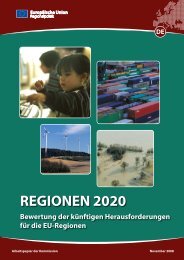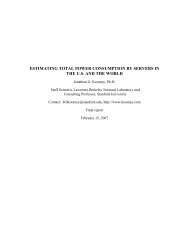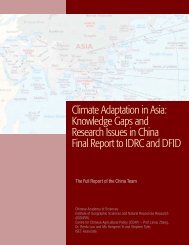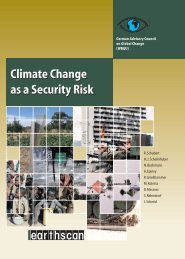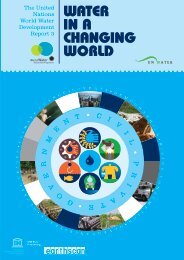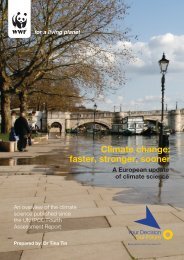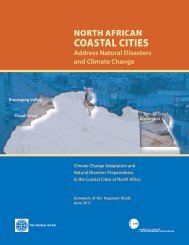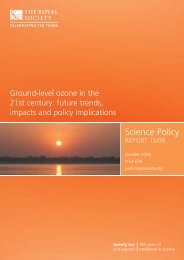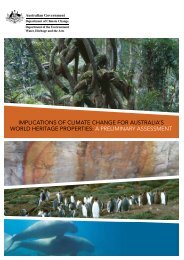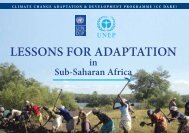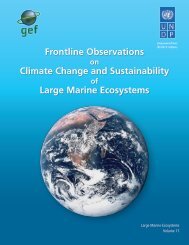Climate change futures: health, ecological and economic dimensions
Climate change futures: health, ecological and economic dimensions
Climate change futures: health, ecological and economic dimensions
Create successful ePaper yourself
Turn your PDF publications into a flip-book with our unique Google optimized e-Paper software.
a better underst<strong>and</strong>ing of subpopulations at risk <strong>and</strong>the information necessary for effective response towarnings. Monitoring <strong>and</strong> evaluation of both theresponse system <strong>and</strong> individual interventions need tobe built into system design to ensure the efficient <strong>and</strong>effective use of resources.RESPONSES INCLUDE:animal <strong>and</strong> freshwater fisheries management; <strong>and</strong>what effect such extremes would have on electricitygeneration <strong>and</strong> transmission. These analogs can be utilizedmuch like modeled meteorological data sets <strong>and</strong>the methods can be exp<strong>and</strong>ed to include other midlatitudelocations around the world.Figure 2.21• Improved social networks <strong>and</strong> neighborhoodresponse plans to transport isolated persons to facilitieswith adequate air conditioning (malls, theaters)• Transport vehicles• Air-conditioned facilities in group-housing settings• Prepared <strong>and</strong> well-distributed treatment facilities.58 | EXTREME WEATHER EVENTSCASE STUDIESA number of structural <strong>change</strong>s can ameliorate the<strong>health</strong> impacts of heat waves by reducing the heatisl<strong>and</strong>effect. (These same measures would stimulateproduction <strong>and</strong> open markets for alternative <strong>and</strong> energy-efficientenergy technologies. They are examples ofharmonizing adaptation <strong>and</strong> mitigation. See Part III forfurther discussion.)STRUCTURAL MEASURES INCLUDE:• “Green buildings,” with relevant building codes <strong>and</strong>insurance policies• Roof gardens to absorb heat• Tree-lined streets to absorb heat• Adequate public transport systems to decreasetraffic congestion• Bicycle <strong>and</strong> walking paths• “Smart growth” of urban <strong>and</strong> suburban areasto minimize commutes• Hybrid <strong>and</strong> renewable energy-powered vehicles toreduce pollution.OTHER MEASURES INCLUDE:• Improved power grids• “Smart” technologies that improve efficiency of utilitygrids by favoring high-use areas during specifichours of the day• Distributed power generation to complement <strong>and</strong>supplement grids (discussed in Part III).RESEARCH IMPLICATIONSQuestions remain regarding agricultural yields inresponse to such an extreme summer; how these conditionswould impact water resources, livestock, wildWildfires in New South Wales, Australia, summer 2003.Image: CSIRO Forestry <strong>and</strong> Forests Products Bushfire Behaviour<strong>and</strong> Management GroupCASE 2. ANALOG FOR NEWSOUTH WALES, AUSTRALIAGeetha RanmuthugalaAnthony J McMichaelTord KjellstromBACKGROUNDHeat, drought, <strong>and</strong> bushfires are not new to Australia.Between 1967 <strong>and</strong> 1999, bushfires in Australia resultedin 223 deaths <strong>and</strong> 4,185 injuries with a cost ofover US $2.5 billion, not including timber losses. Thedrought in southeastern Australia in the austral summerof 2003 was particularly intense <strong>and</strong> sparked widespreadfires. The January fires alone destroyed over500 homes, claimed four lives in Canberra <strong>and</strong>caused over US $300 million in damages (AustralianGovernment 2004).The heat wave that Europe experienced during August2003 revealed the susceptibility of even the industrialaffluent world, rich in infrastructure, when maximumtemperatures soared to 10°C above the historical average,<strong>and</strong> minimum temperatures reached record highlevels. In July 1995, the heat wave in Chicago (USA),where maximum temperatures ranged between33.9°C <strong>and</strong> 40.0°C, resulted in an excess of 700heat-attributable deaths, an 85% increase in mortalitycompared to the previous year (CDC 1995). Whatwould be the impact on mortality if Australia were toexperience a heat wave similar to that of the Europeansummer of 2003?



